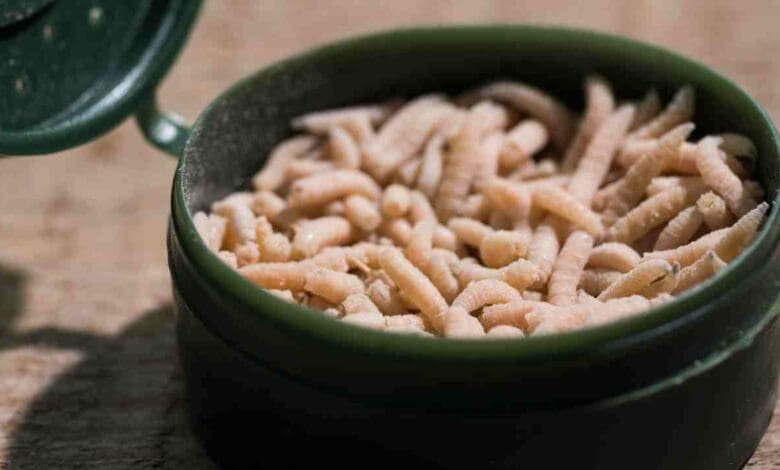Fish Like A Pro: Choose the Perfect Bait for Fishing

A popular question from new fishermen is how to pick a fishing bait. It is easy to get overwhelmed by the variety of bait choices available while starting fishing. There are many enticements to pick from, but you must limit your choices to just a handful for each fishing session.
Although no bait is guaranteed to catch fish, the more you understand about each, the more and more fish you’ll hook. Let’s get you started on the right track by going over some recommendations for common fishing bait options that work.
How to Choose the Right Bait
Deciding what to place at the tip of the fishing line may make a big difference in the effectiveness of your expedition. Mealworms are often the best option as feeders for fishing. They’re one of the most popular and easiest-to-care-for fish feeder bugs.
When it comes to bait selection, there seems to be a wide range of options to consider. Despite their diversity, they all seem to have one goal: to entice the fish to get stuck!
As a fisherman, you should experiment with different alternatives seeing what goes and what doesn’t. That is probably one of the key reasons why fishing is so enjoyable.
Why is it Essential to Pick the Right Bait for Fishing?
Fishing is one of the few activities that can claim to be more fun than others. Although this is true, the fishery may be a difficult journey, especially about selecting the appropriate bait. This is because no one bait will suit all species of fish, weather conditions, or scenarios.
Even yet, the significance of selecting the appropriate bait cannot be overstated. Without a question, your fishing hook is among the most important factors in determining whether you succeed or fail.
Types of Fishing Bait
Many grazing species that make up our sportfish’s typical diets are used in live baits. Bugs, minnows, and worms, for example, maybe obtained in bait stores. Some, such as shad (tiny bait fishes) and frogs, are not commonly offered but may be obtained outdoors with the right equipment and enough time.
The choice of the bait to employ is frequently based on availability. Could it be possible to buy this bait from a neighboring bait shop, or do you have to spend valuable time collecting it before you begin fishing? The answer might help you figure out what works for you.
If you don’t use the bait straight away, you’ll have to use a variety of tactics to keep it alive.
Live Baits for Fishing
Fish baits which are lifeless, rigid, or glassy-eyed are rarely as appealing as those that swim, bounce, and wriggle. Some baits, such as nightcrawlers (large grub worms) and bug nymphs, can be stored in your fridge or cooler until you’re ready to go fishing.
The following are examples of successful live baits:
- Worms: catfish, walleyes, carp, sunfish, trout, black bass
- Minnows: catfish, walleye, trout, white bass, salmon
- Shad/Herring: stripers, hybrid stripers, catfish, largemouth bass
- Crayfish: catfish, trout, rock bass
- Crickets: bluegills/sunfish, crappie
- Frogs: catfish, pickerel, black bass, walleyes
- Shrimp: redfish, black drum
- Leeches: walleyes, black bass, catfish, trout
- Insect larvae: (hellgrammites, mealworms) black bass, walleyes, catfish
- Sand fleas: blackfish, redfish, striped bass, black drum
- Eels: striped bass, tuna
- Bloodworms: perch, seatrout, striped bass
Grocery-bought Baits for Fishing
If you like catfish fishing and don’t have a supply of fresh baitfish, a journey to the market might provide delicious treats. This is what we call grocery baits. Some great ones to consider are:
- Cheese: particularly smelly types
- Sausages: particularly low-cost brands.
- Fresh chicken livers: is preferable to frozen, and the bloodier, the better.
- Spam: is a favorite amongst trophy catfish.
- Canned sweetcorn: a popular bait among anglers since it is colorful and convenient to use.
- Shrimp/squid: Both chilled and processed shrimp/squid go well.
Baits for Commercial Use
Companies have been trying using secret blends of special additives that fish would take just as easily as genuine baits for years. The consequence is a distinct category of man-made incentives available online, in bait stores, and also in discount retailers.
Many contain fragrances or other compounds aimed at stimulating the fish’s smell or taste receptors. They normally keep well at room temperature and may be stored in a toolbox for immediate use. Most of these baits have been designed specifically for catfish fishermen. Dipped baits, dough baits, and tube baits are available in various tastes and fragrances.
To lure panfish, trout, catfish, as well as other fish, some commercial baits use unique additives. These are frequently molded to look like worms, baitfish, or even other organic baits, so while these do not often perform as well as their native form, they can catch fish in a variety of settings and are most effective when used in conjunction with lures and live baits.
Artificial Baits for Fishing
The goal is to imitate the appearance and motion of organic baits. Artificial baits have the advantage of being easily available at fishing shops, requiring less care, and lasting longer, making them very cost-effective. Jigs, soft rubber baits, spoons, spinners, and flies are among them.
Choose Your Baits Wisely Based on the Kind of Fish You Want to Catch
The problems that fishing brings to fishermen make it such a fun pastime. As there is no one-size-fits-all approach to selecting the best bait for all sorts of fish and situations, it’s critical to get creative.
In a nutshell, picking the appropriate bait is mostly about generating informed decisions and offering the bait which your targeted fish will most definitely take. Only then will you have a chance of returning home with a fish! As a result, you should think about the sort of fish you’re going after, their favored prey, the climate, the kind of bait, as well as the fishing rules.
